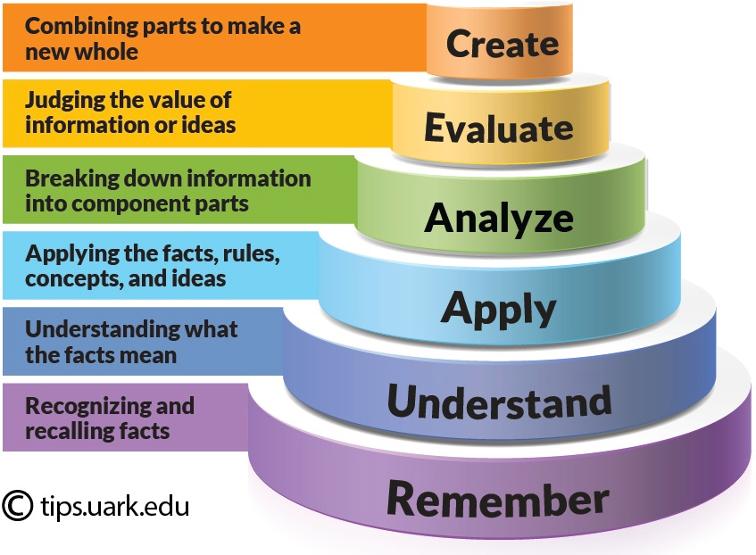Blooms Taxonomy
Create
Evaluate
Analyze
Apply
Understand
Remember
Key Verbs (keywords)
Design, formulate, build, invent, create, compose, generate, derive, modify, develop.
Choose, support, relate, determine, defend, judge, grade, compare, contrast, argue, justify, support, convince, select, evaluate.
Classify, break down, categorize, analyze, diagram, illustrate, criticize, simplify, associate. **************************
Calculate, predict, apply, solve, illustrate, use, demonstrate, determine, model, perform, present. **************************
Describe, explain, paraphrase, restate, give original examples of, summarize, contrast, interpret, discuss. **************************
List, recite, outline, define, name, match, quote, recall, identify, label, recognize.
Example Learning Objective
By the end of this lesson, the student will be able to design an original problem dealing with the principle of conservation of energy. **************************
By the end of this lesson, the student will be able to determine whether using conservation of energy or momentum would be more appropriate for solving a dynamics problem.
By the end of this lesson, the student will be able to differentiate between potential and kinetic energy.
By the end of this lesson, the student will be able to calculate the kinetic energy of a projectile.
By the end of this lesson, the student will be able to describe Newton’s three laws of motion to in her/his own words **************************
By the end of this lesson, the student will be able to recite Newton’s three laws of motion.
How Bloom’s can aid in course design
Bloom’s taxonomy is a powerful tool to help develop learning objectives because it explains the process of learning:
- Before you can understand a concept, you must remember it.
- To apply a concept you must first understand it.
- In order to evaluate a process, you must have analyzed it.
- To create an accurate conclusion, you must have completed a thorough evaluation.
However, we don’t always start with lower order skills and step all the way through the entire taxonomy for each concept you present in your course. That approach would become tedious–for both you and your students! Instead, start by considering the level of learners in your course:
How Bloom’s Taxonomy works with learning objectives
The “verb table” above helps to identify which action verbs align with each level in Bloom’s Taxonomy.
You may notice that some of these verbs on the table are associated with multiple Bloom’s Taxonomy levels. These “multilevel-verbs” are actions that could apply to different activities. For example, you could have an objective that states “At the end of this lesson, students will be able to explain the difference between past and present tense.” This would be an understanding level objective. However, if you wanted the students to be able to “…explain which tense would be more suitable for giving directions. This would be an analyzing level verb.
